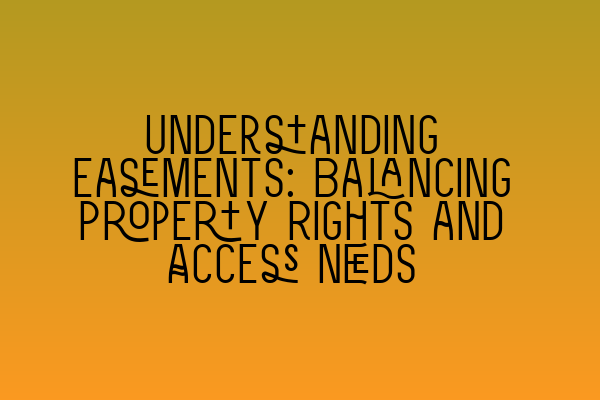Understanding Easements: Balancing Property Rights and Access Needs
When it comes to property law, one essential concept that often arises is the idea of easements. Easements play a significant role in balancing property rights and access needs, ensuring that individuals can enjoy their properties while also providing necessary access to others. In this article, we will explore the ins and outs of easements, their importance, and how they work within the legal framework of property law.
To start, let’s define what an easement is. Simply put, an easement is a legal right to use someone else’s land for a specific purpose. It allows for a person or entity (known as the easement holder) to access or use a portion of another person’s property without actually owning it. Easements can be created in various ways, such as through express agreements, implied agreements, or by necessity. They can also be created for specific purposes, such as granting access to a neighboring property, allowing for the installation of utility lines, or providing a right of way.
Now, let’s delve into the importance of easements in balancing property rights and access needs. Easements serve as a crucial tool for maintaining harmony and fairness between neighboring property owners. They ensure that one person’s property rights do not impede the access needs of another. For example, imagine a landlocked property that has no direct access to a public road. In such a case, an easement can be granted to the landowner, allowing them a right of way over a neighboring property to reach the main road. Similarly, easements can protect the interests of utility companies, enabling them to install and maintain vital infrastructure on private properties.
Understanding the different types of easements is essential in navigating property law. Let’s explore a few common types:
1. Right-of-Way Easements: This type of easement grants someone the right to pass through another person’s property, such as a pathway or road, to access their own property. Right-of-way easements are often seen in suburban or rural areas where properties may not have direct access to public roads. They are crucial for ensuring the practicality and value of landlocked properties.
2. Utility Easements: These easements allow utility companies to access private properties to install and maintain utility lines. Utility easements are necessary to ensure that properties can receive essential services, such as electricity, gas, and water. They provide a balance between private property rights and the collective need for public utilities.
3. Conservation Easements: Conservation easements are designed to protect and preserve natural resources and cultural heritage. They can restrict certain activities on a property to maintain its environmental or historical integrity. Conservation easements are often created voluntarily to ensure the sustainability and long-term viability of natural habitats and important landmarks.
4. Recreational Easements: Recreational easements allow for public access to private properties for recreational purposes. They can grant rights to use trails, lakes, or other recreational facilities. Recreational easements promote the enjoyment of open spaces for all, while respecting the private ownership of the land.
It is important to note that easements can be either appurtenant or in gross. Appurtenant easements are typically connected to the specific properties involved and pass with the land when it is sold or transferred. In contrast, easements in gross are personal rights that belong to an individual or entity, rather than being tied to a specific property. Understanding the type of easement involved is essential in determining its scope and requirements.
As property lawyers, we understand the complexities that can arise with easements and the need to balance property rights and access needs. If you find yourself in a situation where an easement is required or contested, it is crucial to seek professional legal advice. Our expert team at SQE Property Law & Land Law can provide the guidance and expertise needed to navigate easement disputes and ensure that your property rights are protected.
In conclusion, easements are a vital component of property law, allowing for the balance of property rights and access needs. Whether it is granting access to landlocked properties, ensuring utility infrastructure, or protecting natural resources, easements play a significant role in maintaining harmony within property ownership. Understanding the various types of easements and their implications is essential in effectively managing property rights and ensuring fair access for all.
If you’re studying for the SQE 1 Exam, be sure to check out our related articles on SQE 1 Practice Exam Questions and SQE 1 Practice Mocks FLK1 FLK2. And if you need preparation courses for the SQE exams, we offer both SQE 2 Preparation Courses and SQE 1 Preparation Courses. For information about exam dates and other important details, visit our page on SRA SQE Exam Dates.
